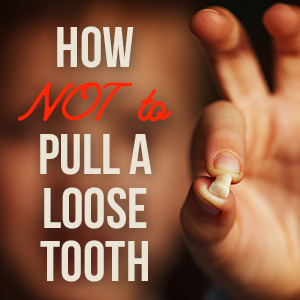How NOT to Pull a Loose Tooth
 We’ve all seen variations of DIY methods when it comes to pulling loose baby teeth: the string and door slam method is by far one of the most popular (although we’re not sure why). But our team at A Smile By Design is here to advise against this and similarly aggressive techniques so your kiddo will have the safest and most painless tooth loss experience possible. (Growing up is traumatic enough already, right?)
We’ve all seen variations of DIY methods when it comes to pulling loose baby teeth: the string and door slam method is by far one of the most popular (although we’re not sure why). But our team at A Smile By Design is here to advise against this and similarly aggressive techniques so your kiddo will have the safest and most painless tooth loss experience possible. (Growing up is traumatic enough already, right?)
Read on to learn more about the dos and don’ts of helping wiggly baby teeth make their grand exit.
Why baby teeth?
All this wiggly tooth talk might have you wondering–why do we get two sets of teeth? Well, simply because baby mouths are not yet big enough to house a full set of adult chompers. So, we start out with a smaller set of baby teeth to get us through these early, small-mouthed years until our growth and development allows more space for adult teeth to make their entrance. When the permanent teeth start to come in, the roots of the baby teeth dissolve until they’re loose enough to fall out on their own.
Patience is a virtue
If you ask Dr. James Vogler their advice on pulling a loose baby tooth, they will likely respond with, “Don’t!” If you can avoid it, it’s best to just let baby teeth run their natural course and fall out on their own—it will happen eventually, we promise!
If the tooth is not ready to come out naturally, any attempts to remove it will pull on sensitive tooth roots and cause unnecessary pain and bleeding. Pulling out a tooth prematurely can damage connective tissues and lead to infection—not to mention the traumatic experience that may create negative feelings about oral health and dental visits for the rest of their life.
However, an extremely wiggly or stubborn tooth that just keeps hanging on by a thread can be frustrating and hard to live with, and we understand why both you and your kiddo might want to expedite the process. If you both feel the tooth is ready to come out and you want to give it a little encouragement, there are some things you can do to help it along.
-
Wiggle baby wiggle
Encourage your soon-to-be toothless wonder to wiggle their loose tooth back and forth regularly, either with their tongue or with clean fingers. Wiggling the tooth will help loosen it so hopefully, it will fall out on its own.
-
An apple a day
If the tooth is loose enough and on the brink of coming out, eating a crunchy or sticky snack might be just the ticket. Apples and carrots are great healthy options, but if your little one is fearful and needs a little more encouragement, you can opt for a sweet treat like a popsicle (which will also help reduce pain and inflammation) or a sticky tooth trap like a chewy candy. Supervise closely to ensure they don’t bite down on or swallow the tooth.
-
Brush & floss
Brushing regularly at least twice per day and flossing daily is always recommended and will give the loose tooth a nudge in the right direction. You can also use floss as a tool for pulling the tooth—if it’s ready to pull. Position the floss in between the gums and the loose tooth and yank quickly outward.
-
Twist & pull gently
If you’ve wiggled and wiggled and the tooth is still hanging on by a thread, a gentle twist and pull might be all it takes to pop it out. We encourage you to allow your child to be the one to do so, as they are the only one who can tell if the tooth is ready to pull and feel if (or when) there’s any pain. Use clean fingers or gauze to gently twist and pull the tooth out.
To recap, our best advice is to have patience and allow your child’s baby teeth to fall out naturally on their own. But if they just can’t stand it any longer and the tooth is ready to come out, follow our advice above for the safest, most comfortable, and least traumatic methods.
As always, if your child experiences any pain, swelling, or excessive bleeding, or the tooth still won’t come out, you should come to see us right away and we’ll remove the tooth safely and painlessly. Contact your Dansville dentist, Dr. James Vogler at A Smile By Design today for more advice or to schedule an appointment.
The content of this blog is not intended to be a substitute for professional medical advice, diagnosis, or treatment. Always seek the advice of qualified health providers with questions you may have regarding medical conditions.











